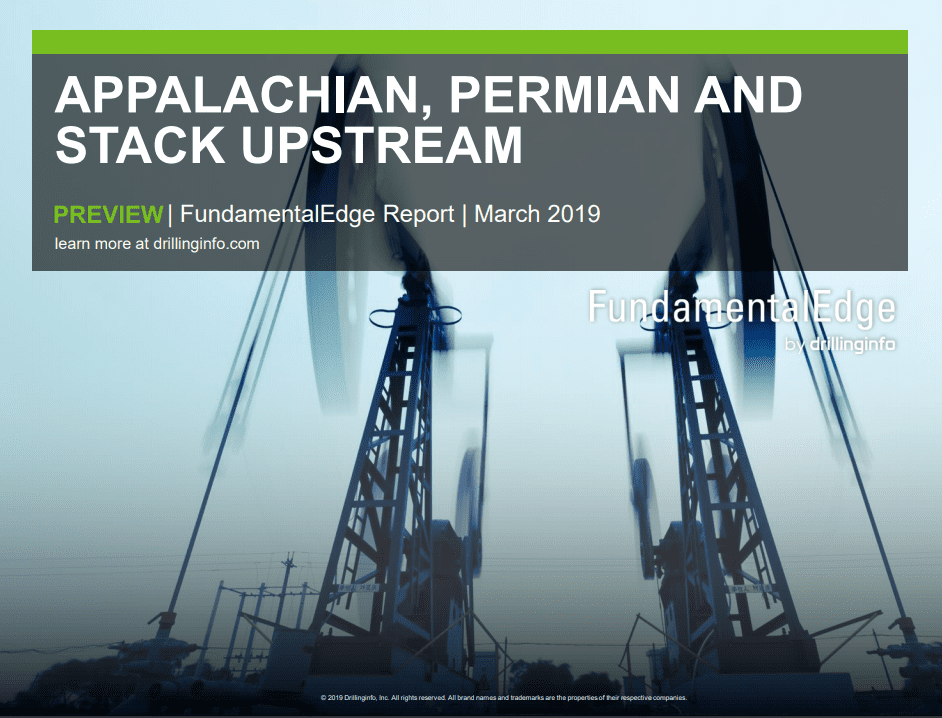Austin, TX – Drillinginfo, the leading energy SaaS and data analytics company, has released the latest installment of its FundamentalEdge series. This is an interim report covering the most recent trends in the upstream sector for the Appalachian, Permian and STACK basins.
“Even though oil and gas production has seen a dramatic increase over the past ten years, we don’t expect it to slow down anytime soon,” said Sarp Ozkan, Director of Energy Analysis at Drillinginfo Market Intelligence. “We’re anticipating another ten years of growth, but that comes with a caution about oil production. As companies focus on shareholder returns rather than the rate of growth, we could continue to see consolidation that we wouldn’t otherwise see. Wall Street’s demands are being factored into equity prices, which is clearly having an impact, but we need to find a balance.”
“Its no longer accurate to talk about the Permian in general,” added Ozkan. “Specifically, the Delaware basin has seen activity skyrocket and the number of horizontal spudded wells set a new record last year. Efficiencies in the Delaware have increased year over year since 2013, and in some cases forty percent. Those are the highest IP rates in the basin, however it remains to be seen how operators deal with the negative impact of parent-child infill well productivity,” said Ozkan.
Drillinginfo’s area type curve economic analysis follows the drilling activity and trends seen from the A&D market. There is a clear depiction of a core Tier 1, with lower tiers moving farther from the best areas in the basin. Tiers are based on a weighted score using EURs, proven formations and economics.
Elsewhere in the US, the Anadarko and Appalachian basins hold great promise for increased natural gas production. Anadarko gas production is expected to reach 12.39 Bcf/d in Dec. 2030, up from 7.75 Bcf/d at the end of 2018. The Appalachian basin is expected to reach 37.1 Bcf/d by the end of 2030.
Key Takeaways:
- Crude oil and natural gas production continue setting record highs in the US. This growth is happening despite the lower rig count, as horizontal rigs hold higher initial production rates compared to traditional vertical drilling.
- In the Permian basin, economics support strong production growth, with many areas holding breakevens as low as $30-40/Bbl. The Delaware basin leads the production gains for the Permian, where type curves show gains as high as 40% per year.
- In the Anadarko basin, the STACK play is expected to bring more than 50% of the oil and gas production growth in the next 5 years. Within the STACK, many different formations are targeted across the play, as the over-pressured window and the normally pressured window yield different results across the play in terms of well results.
In 2018, dry gas production in the Appalachian basin increased by almost 4 Bcf/d following the commencement of service of multiple pipelines that allowed the gas to reach a final destination market. Based on DI’s type curve analysis, the area in Pennsylvania North (part of the Marcellus) holds the best economics, yet drilling activity continues to be restricted by takeaway capacity constraints in this area. The midstream capacity additions have mainly benefited Utica producers, therefore attracting most of the production activity.
 Loading...
Loading...
About Drillinginfo
Drillinginfo delivers business-critical insights to the energy, power, and commodities markets. Its state-of-the-art SaaS platform offers sophisticated technology, powerful analytics, and industry-leading data. Drillinginfo’s solutions deliver value across upstream, midstream and downstream markets, empowering exploration and production (E&P), oilfield services, midstream, utilities, trading and risk, and capital markets companies to be more collaborative, efficient, and competitive. Drillinginfo delivers actionable intelligence over mobile, web, and desktop to analyze and reduce risk, conduct competitive benchmarking, and uncover market insights. Drillinginfo serves over 5,000 companies globally from its Austin, Texas, headquarters and has more than 1,000 employees. For more information visit drillinginfo.com.






